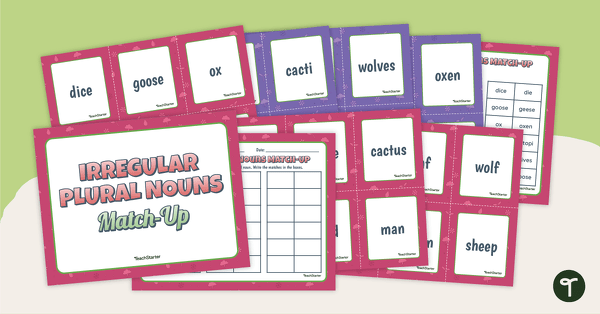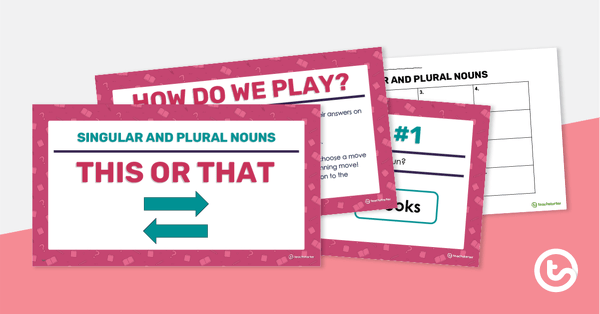Plurals Teaching Resources
Teach students about plural nouns and verbs and irregular plurals with printable worksheets, activities, and more created by ELA teachers for your elementary classroom!
This collection of curriculum-aligned teaching resources has undergone an in-depth review by members of our teaching team to ensure each resource is classroom-ready. With editable curriculum-aligned resources, you'll be able to meet Common Core and state standards while also differentiating instruction for the individual students in your classroom.
New to teaching about plural nouns and verbs? Take a peek at this primer from our teacher team!
What Are Plural Words?
You don't need us to tell you that plural words, by definition, are the words in the English language that indicate more than one person, place, thing, or idea. Add an "s" to "cat," and you have "cats" — meaning multiple felines. Add an "es" to "couch," and you get couches — meaning multiples of the popular piece of furniture. And so on.
We teach our students about plural nouns because we want them to be able to express quantity and talk about multiple objects or people both as speakers and writers. But the importance of this part of the ELA curriculum extends even further.
Teaching plurals gives students a fundamental building block for future grammar studies and they're something that's often tested on standardized tests.
How to Make Words Plural
Like many rules of the English language, plurals can be tricky for young readers and writers to learn because they don't always follow the same rules.
Most singular nouns become plural nouns by adding an "s" at the end of the word, however, other nouns become plural by adding an "es" or even an "ies." There are also irregular plural nouns for students to learn, which take their own unique forms.
Here are some basic plural rules to teach in your classroom:
- To make most nouns plural, add –s to the end.
- If a noun ends in –s, –ss, –sh, –ch, –x, or –z, add -es to the end to make it plural.
- If a noun ends –o, add –es to make it plural.
- If a noun ends in –y and the letter before the –y is a consonant, change the ending to –ies to make the noun plural.
- If a noun ends in –y and the letter before the –y is a vowel, add an –s to make it plural.
- If a noun ends with –f or –fe, the f or –fe are often changed to –ve before adding the –s to make it plural.
Which Parts of Speech Can be Plural?
As our students learn the different types of speech, they're bound to ask how to pluralize them. It's important to note that not every type of word can be made plural!
Plural nouns and plural verbs exist in the English language, and subject-verb agreement in sentences dictates the following:
- If the subject of a sentence is singular, the verb must be singular too.
- If the subject of a sentence is plural, the verb must also be plural.
- There are no such rules for adjectives, which do not have singular and plural forms.
- Plus Plan

Christmas Plural Nouns Worksheet
Practice identifying singular and plural nouns with this Christmas worksheet.
- Plus Plan

Irregular Plural Noun Practice Worksheet
Practice identifying and using common irregular plural nouns on this single-page worksheet.
- Free Plan

Plural Nouns Chart - Printable Plural Rules Guide
Give your students a reference guide to help them remember all of the different plural rules.
- Plus Plan

Spelling Words with -s, -es, and -ies Worksheets
Practice using the inflectional endings -s, -es, and -ies with a pack of English worksheets.
- Plus Plan

Irregular Plural Noun Match-Up
Practice using irregular plural nouns with an Irregular Plural Noun Matching Activity.
- Free Plan

Read and Color Worksheet - Singular and Plural Nouns
A worksheet to practice identifying singular and plural nouns.
- Plus Plan

BUMP! - Irregular Plural Nouns Board Game
A board game to practice forming irregular plural nouns.
- Plus Plan

This or That! PowerPoint Game - Singular and Plural Nouns
An active PowerPoint game to practice working with singular and plural nouns.